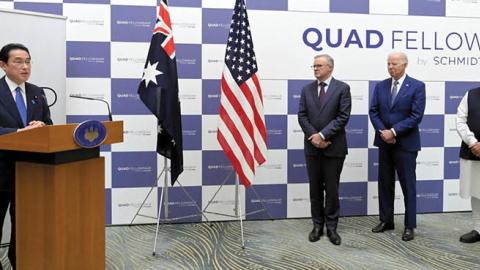President Biden’s participation in a summit meeting of the Indo-Pacific “Quad,” which groups Australia, Japan, India and the United States in competition with China, demonstrates the importance of East Asia and the South Pacific in current U.S. policy. But it is a different group of four countries that seems to be making greater progress.
The West Asia Quad – a grouping of India, Israel, the UAE and the United States – was launched in October 2021 with a lot less fanfare than what accompanies the Indo-Pacific partnership. But it has already resulted in a free trade agreement and multiple cooperative arrangements. Unlike the Indo-Pacific Quad, which avoids hard security questions, the West Asian partnership embraces a realistic assessment of shared threats.
The idea for the West Asia Quad came from Israel and the UAE with strong support from the U.S. Secretary of State Antony Blinken spoke of the four countries leveraging each other’s “complementary capabilities” in the Middle East while Israeli Foreign Minister Yair Lapid emphasized the “synergy” in “infrastructure, digital infrastructure, transport, maritime security.”
Instead of focusing on the challenge from a single rising power, the West Asia Quad is brought together, in the words of UAE Foreign Minister Abdullah Bin Zayed, by the special bonds that “distinguish” relations between these countries. Indian External Affairs Minister S. Jaishankar has noted that UAE, Israel, and the United States are India’s “closest relationships,” and these close ties make the four countries more willing to work together.
In early May, UAE’s minister of economy led a 70-member business delegation to Delhi and Mumbai to discuss ways to further promote trade and investments in India and the UAE. This was a follow up to the February 2022 free trade agreement that both countries signed and that came into force on May 1. A similar free trade deal already exists between Israel and the UAE, while one between India and Israel is in the pipeline.
The UAE is already one of India’s top trading partners, just behind the U.S., China and the European Union in trade volume. Bilateral trade between the two countries was $59 billion last year, and Emirati companies have invested $18 billion in India. The UAE also hosts 3.4 million Indian workers, whose remittances are an important component of India’s $83 billion hard currency earnings in remittances. The UAE has helped address India’s concerns about oil security by contributing to India’s strategic oil reserves.
The Israel-India partnership is also robust, and Israel is one of the top three suppliers of defense equipment to India. Forty-three percent of Israel’s arms exports are sold to India. India’s bilateral trade with Israel, currently at $4.14 billion, is growing. Israel exports agricultural technology, cyber technology, health care technology and defense equipment to India, while India sells mineral products, machinery and textiles to Israel.
The West Asia Quad is brought together by shared interests and complementary capabilities. This differs from the Indo-Pacific Quad, where, notwithstanding American enthusiasm, the partners do not always offer what the other needs. The four countries do not have free trade agreements like Israel, India and the UAE seem to have worked out. Each of them knows they must work together against China, but they seem to be taking time in figuring out what they might get from one another. Japan, for example, wants to replace China as Australia’s major trading partner but is unable to offer any security advantage to Australia in return.
There is no such ambiguity in the West Asia Quad. While the U.S. brings its military prowess to the table, other partners are able to make significant contributions to each other’s security or economy. The UAE’s strategic pragmatism provides a glue for the grouping while assuring India of energy supplies and employment opportunities for a vast population. The UAE sees India as an external power that balances China and is not viewed by the U.S. as a threat.
Israel’s technological and economic muscle, and military-intelligence prowess, partners well with India’s ability to provide manpower and access to a large market. The UAE’s bold move to recognize Israel, and its firm commitment to the Abraham Accords, has drawn it close to Israel.
This puts the UAE in a position to influence Israel in protecting Palestinians in Gaza and the West Bank, while also being the staunchest Muslim opponent of radical Islamist extremism. India, which is home to 200 million Muslims and has been a victim of terrorism like the November 26, 2008, Mumbai attacks, appreciates Israeli and Emirati support against terrorists
The West Asia Quad works because it brings together two key economies of the Middle East – Israel and the UAE – with a more assertive India and the resident external power, the United States. If the Indo-Pacific Quad is to succeed, it too will have to find complementarities among its members similar to those members of the West Asian Quad have successfully identified.
Read in The Hill
















